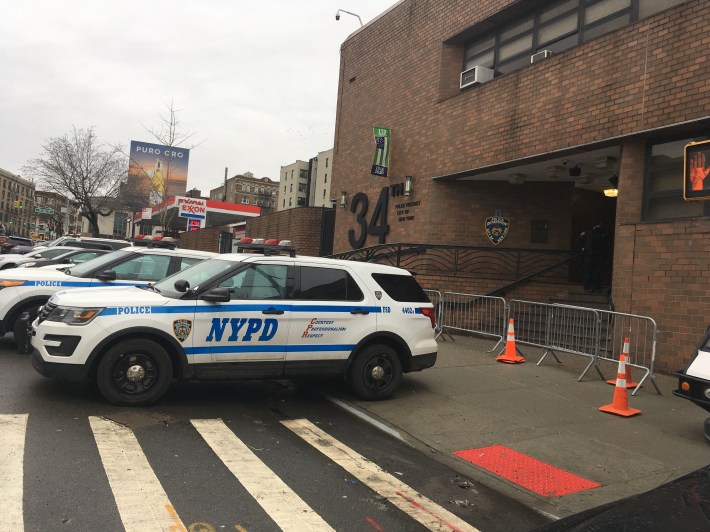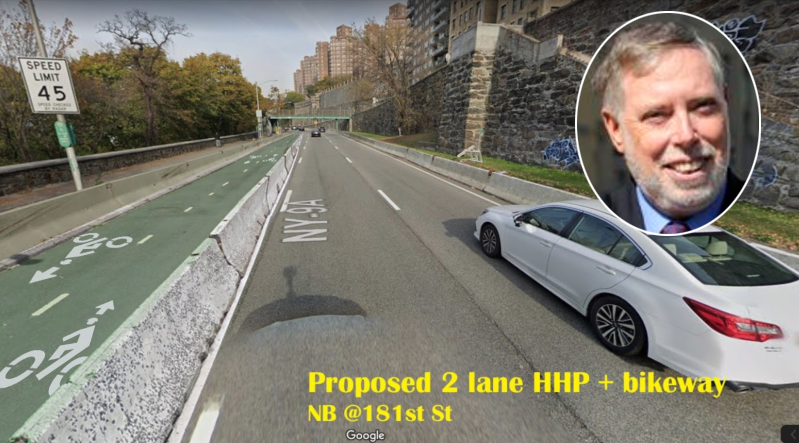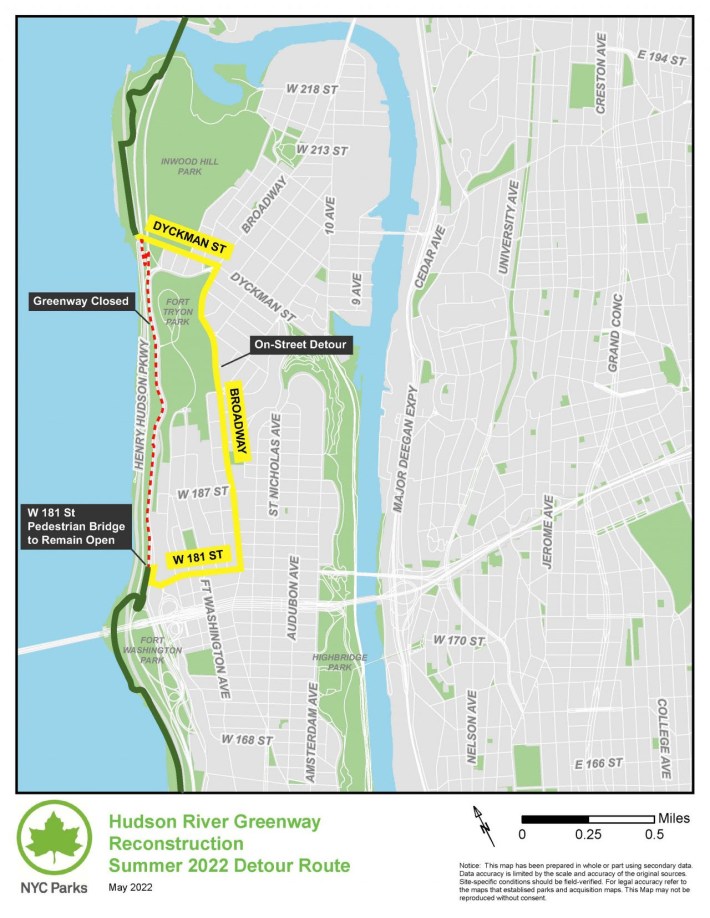A former traffic commissioner is pushing back on cars.
Sam Schwartz, aka "Gridlock Sam," wants the city to take a lane away from drivers on the northbound Henry Hudson Parkway and give it to the beleaguered cyclists of northern Manhattan and the west Bronx when the Parks Department closes a northern part of the Hudson River Greenway this month. The existing bike path runs alongside the westernmost lane of the north-bound spur of the highway.
"The northbound Henry Hudson Parkway has three lanes, but easily could get by with two," Schwartz told Streetsblog this week. "Traffic never reaches capacity on the HHP north of the George Washington Bridge, so taking a northbound lane and having a temporary bike path using the left shoulder and left-most lane separated by a Jersey barrier is far superior and much safer than sending bike riders through the street system of upper Manhattan."
The current plan, which was supposed to begin this week, calls for the Parks to close a one-mile stretch of the greenway between Dyckman Street and the George Washington Bridge for at least four months for repairs. During the closure, the Parks Department wants walkers and bikers to instead access congested, dangerous Broadway from W. 181st Street and Dyckman Street, which are hilly streets that encompass northern Manhattan's main truck and freight route. The recommendation has rankled cycilsts, who use the greenway as the only safe north-south transit route as well as a leg of the 750-mile Empire State Trail.
The detour is unsafe. From May 2020 through April 2022, there were 255 reported crashes on the detour streets, injuring 20 cyclists and 18 pedestrians, according to city data, with a higher incidence of collisions during the summer when the greenway gets more use.
A year ago, Manhattan Community Board 12 formally asked the departments of Parks and Transportation to study the idea of erecting a bike detour on the parkway during the construction. The plan, forwarded by some local residents with engineering backgrounds, proposed to use inexpensive Jersey barriers to make a temporary bike lane in the underused western lane of the northbound parkway. In order to do so, the city would need the permission of the state DOT, which controls the road (also known as state Route 9A). The greenway in that stretch lies at the western edge of the northbound parkway lanes, to the east of the southbound leg of the bifurcated road.
The state, for its part, did not reject the idea out of hand — but said that the city would have to request a review. The city never did so — even though, according to traffic engineer Schwartz, it makes good sense and would represent a small measure of justice.
"The city and state go to extraordinary lengths to not close a highway for drivers when construction is needed," he said, recounting that, a couple of decades ago when he was involved in the reconstruction of the FDR Drive in Midtown, "rather than close the drive, we built a temporary highway in the East River!" The extension is being turned into the East Midtown Waterfront.
A Henry Hudson Parkway bike lane would provide immediate relief to bike commuters such as Stella Billings, who said that she and her 13-year-old, who used the greenway to get to school, have abandoned riding because of the construction.
"The idea of anyone, let alone young teens, taking the unprotected death trap that is Broadway between Dyckman and 181st is outrageous!" Billings said. "Sadly, the alternate route they propose is not a detour at all in our minds — just a complete shut down of access during peak riding months."
The Broadway detour is only the latest instance of what bikers describe as dismissive treatment from the Parks Department. Brooklyn bikers are up in arms because Parks declined to ensure a safe route during a year-long repair of the Brooklyn Greenway. A repair of the Cherry Walk section of the Hudson River Greenway in Riverside Park two years ago brought complaints about lack of notice and poor signage. Other complaints have arisen over the years because of prolonged closures of the East River Greenway downtown for flood remediation and uptown for sinkhole fixes. Even on the upper Hudson River Greenway, Parks has dawdled with repairs. For instance, in 2018 it only moved on fixing a pedestrian bridge there that spans the tracks at West 181st Street after Streetsblog highlighted the issue.
And, of course, Ocean Parkway is also a Parks Department infrastructure catastrophe. The agency has also failed to provide safe routes for cyclists through Central Park, where a beloved doctor was killed in 2019.
"Mayor Adams should get stuff done for cyclists right now by removing the greenway from Parks Department jurisdiction," said Inwood resident (and transit advocate) Danny Pearlstein, an all-year cyclist who has used the Hudson River Greenway for more than a decade. "Parks has consistently failed to prioritize the needs of users of the nation's busiest bike path, the crown jewel of the city's greenway network. The latest closure, with its last-minute hazardous detour, just adds insult to injury after years of gross inattention to the infrastructure and callous attacks from bike-fearing bureaucrats. The future of sustainable transportation in New York demands that City Hall intervene now to treat the greenway as the premier transportation route that it is."
Contrary to Pearlstein's criticisms, the Parks Department said that it "worked with DOT to determine the best possible detour to accommodate pedestrians and cyclists," according to spokeswoman Megan Moriarty, who added that the detour was "determined based on knowledge of best available bike routes in the area." She said that aforementioned West 181st Street pedestrian bridge — which enables people to access the upper greenway from the park and to continue south on the greenway below — would help commuters by remaining open during the construction.
The DOT declined to comment, referring us to Parks.
Besides trucks, the Parks-designated detour holds a number of other hazards. Officers of the 34th Precinct at 4295 Broadway combat park their personal cars diagonally into Broadway, presenting dangers for all street users, even other motorists. Meanwhile, the MTA will be putting even more vehicle traffic in the area: The agency said that it will shut down the A train above 168th during many weekends this summer because of station work at 181st Street, CB12 announced on Monday. The A Train runs along Broadway north of 181st Street; thus, any closure would put dozens of shuttle buses for passengers on the same route as Parks' recommended cycling and walking detour.

There are precedents for re-allocating space on 9A because of construction: Repair of the collapsed Castle Village retaining wall at 183rd Street closed a lane of Henry Hudson Parkway for a year starting in 2005. Meanwhile, further south in Manhattan, where 9A is called West Street, it hosted a detour for bikers from 14th to 16th streets for a week during work hours when Pier 57 was undergoing construction in 2021.
Nor is it unusual for city agencies to operate on Henry Hudson Parkway, despite its designation as a state road. The NYPD, for example, responds to crashes and helps distressed motorists, even ones who may not legally drive on the route (as in the tweet below).
Here’s another reminder why trucks are not allowed on the Henry Hudson Parkway (photo by @EJKessler) pic.twitter.com/iJJY1hbAN8
— Streetsblog New York (@StreetsblogNYC) May 16, 2022
In any event, Henry Hudson Parkway exists in the first place because in the 1930s Robert Moses commandeered a city street — Riverside Drive — widening it in order to create the highway. The stretch of the greenway being repaired, in fact, runs along the old RSD sidewalk and still contains markers that say so.







